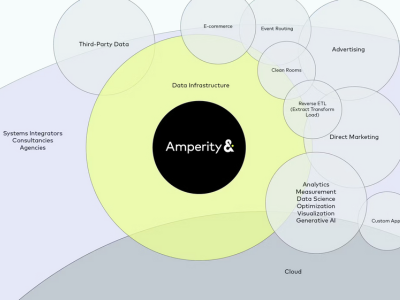Data empowered is the new data-driven
September 21, 2023“Data-driven decision-making” – a business strategy so powerful, it forever changed the way we work. 20 years on, our ever-growing dependence on data calls for a re-evaluation of how we interact with it, advocating for harmony, comfort and confidence between humans and this intelligent technology.
In 2018, Amazon developed an AI recruiting tool designed to review résumés and select the best candidates. It used data from the résumés of high-performing employees to identify who would become the most successful hires, significantly reducing time spent on a monotonous process. A brilliant application of data-driven decision-making, right? Sadly, not quite.
The program discriminated against women by placing a positive bias on words men would more typically use, such as “executed” and “captured”, and downgraded words more commonly used by women, such as “developed” and “supported”. It wasn’t until the team peeled back the layers and looked deep into the data that they uncovered this connection, and more importantly, the real impact of letting data alone call the shots
You see, while data-driven decision-making has dominated business practice for more than two decades (to the point where eyes may glaze over at the ‘corporate buzzword’ perception of the phrase), blindly following data is not a sustainable nor a responsible solution, but there’s no greater tool to analyze past patterns and uncover insights. Thankfully, there is a way to navigate this dilemma. Enter a data-empowered mindset.
Data empowerment puts people back in the driver’s seat. Emerging as a new term in academia and in the media, it refers to providing the tools, knowledge and access to utilize data effectively. A movement of sorts that advocates for the best parts of data-driven decision-making in a revised framework that promotes confidence, understanding and safety.
Here are the key tenets of this up-and-coming mindset:
Don’t fear more data, fear hidden data
The first step to data empowerment? Access and visibility to all relevant data. But it’s not as simple as it seems, as data capture sources multiply and diversify, and the sheer quantity of data soars.
Those keen to achieve internal data transparency need to consider how their data is stored and organized. The best tools, such as Customer Data Platforms (CDPs), will go beyond organizing, sorting and cleaning mass data inputs. They will provide the unrestricted ability to dig into as much information as possible, enabling companies to explore the depths of their own data – no matter how raw.
The perfect platform would support access to the variety of analytical and technical skills across a business. Providing both high-level insights for leadership and marketers, who often prefer summaries and actionable next steps; while also enabling visibility of primary, untreated data for technical teams who are committed to crossing I’s and dotting T’s.
Establish a quality standard and don’t deviate from it
From management to control: teams that work with data should take pride in establishing quality parameters and controlling them. This includes outlining a framework of ‘good’ and ‘bad’ data and configuring custom attributes and values to ensure data is accurate, complete, consistent, timely, relevant, and valid. Holding true to these standards enables easier identification of spikes, changes or bugs, while ensuring a consistent, watertight dataset that organizations can utilize to derive insights and make decisions that are informed and reliable.
With full control of their data, teams can vouch for this level of detail – and this is where true empowerment stems.
Anything less than best practice is not good enough
An important but sensitive, and sometimes controversial aspect of the data empowerment conversation is data governance and security. There’s no need to detail the risks and consequences of underestimating this aspect of data management – this is splattered across the internet – however, talking about it now is a complete necessity.
A well-defined governance framework built on ethical best-practice is a must-have for every organization managing data. It should cover all relevant policies on how to treat and handle data at every level, and once established, these company-wide processes, expectations and restrictions must be well-regulated.
Equally important, these practices should be underpinned by a robust security system. Encryption software, intrusion detection, anti-virus, firewalls are just the basics. Unauthorized access or misuse of data in any form naturally needs to be heavily reprimanded. End of story.
Empowerment can’t exist without education
It’s hard to imagine a time before mass literacy, but of course, language far preceded the written word. One day data literacy is likely to be seen in the same way, and with growing prevalence of data in our daily lives, it’s about time widespread data literacy catches up.
The new skill set encompasses the ability to recognize patterns, relationships, and trends in data to uncover insights. It also involves having a solid understanding of the correct data terminology and the ability to communicate effectively about it. Plus, it requires a shared understanding of the fundamental concepts and techniques that underpin the field of data science. There is more to it than may meet the eye! Lastly, while data visualization formats can sometimes support data literacy by making complex data more accessible, they do not entirely replace the importance of person-to-person knowledge sharing.
Once a certain level of data literacy is attained, tasks that previously required outsourcing, a costly and time-consuming approach, can now be performed in-house. With a holistic view of organizational objectives, an accountable and unbiased individual is precisely the type of person you want to handle critical data-driven tasks.
Cultivating a conducive environment to thrive with data
Though it may sound counterintuitive to the technical data of nature, one of the most impactful aspects on the road to data empowerment is the cultivation of a positive data culture. The best platforms, processes and strategies in the world won’t thrive without shared attitudes, beliefs and behaviors in favor of becoming a data-empowered business. Instilling a data empowered culture requires trust, reliability and collaboration in the approach. Judgment should be discouraged and sharing celebrated.
There are several ways to cultivate a conducive environment to help organizations thrive with data:
- Encourage employees to use data in their day-to-day work and decision-making processes.
- Ensure that your organization has the necessary technology and infrastructure to collect, store, and analyze data effectively.
- Create opportunities for employees to work together on data-driven projects. Encourage cross-functional collaboration and knowledge sharing.
- Train employees on how to interpret and use data effectively. Provide training on statistical analysis, data visualization, and data management.
- Encourage a culture of experimentation, where employees are encouraged to test new ideas and learn from their successes and failures.
- Encourage innovation and experimentation with new data sources, technologies, and analytical methods.
- Regularly track and monitor progress towards data-driven goals. Use metrics to measure success and identify areas for improvement.
We can already see this tide turning. The general public is more confident in exploring how their data works for them and non-technical teams are daring to deep-dive into the numbers to analyze trends in consumer behavior, sales performance, social media engagements, website analytics and more! Individuals and organizations that have access, visibility, quality, control, governance, security, literacy, visualization and a positive culture around the use of data will be set up for success in their data journey, helping them make key data-driven decisions.
Lexer’s latest CDP improvement, Datasets, offers even deeper access to customer data, providing more control, access and application to really know your customer. Learn about how this works now and stay tuned for the new product update to be released soon.
To learn more about Lexer’s CDP and how we can help, book a demo with our team today.



